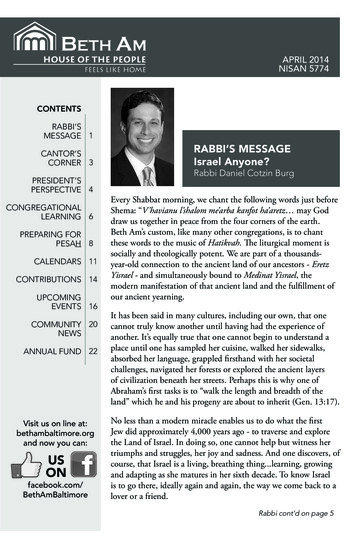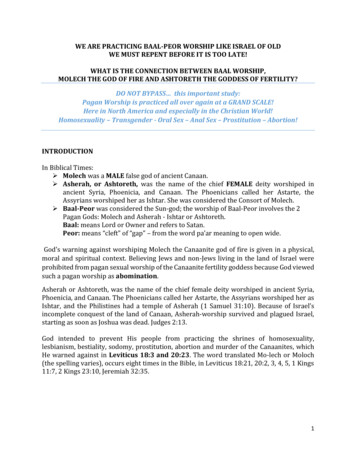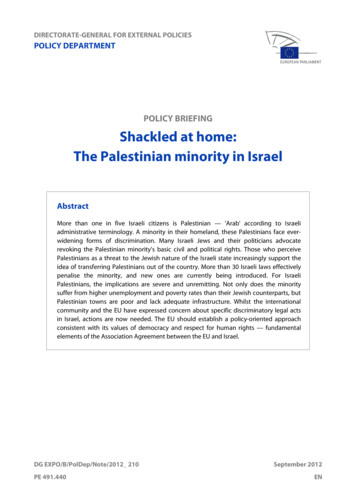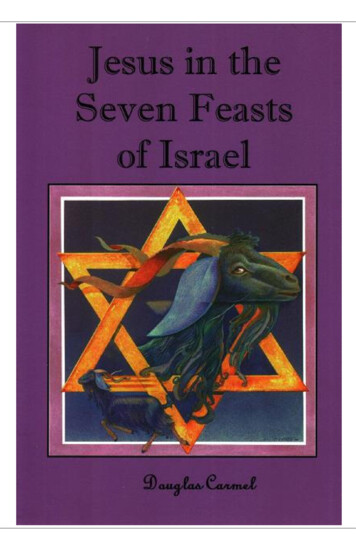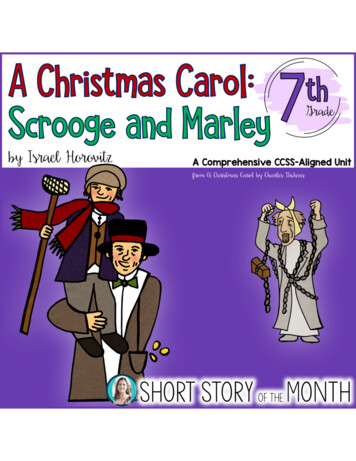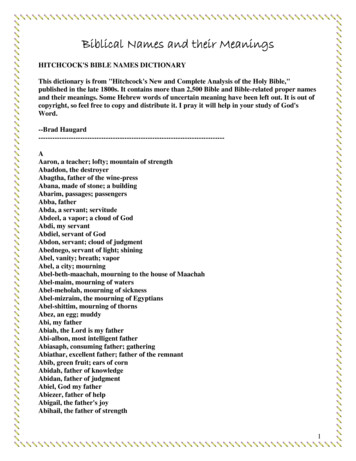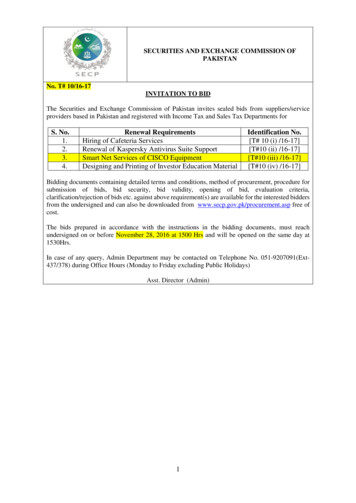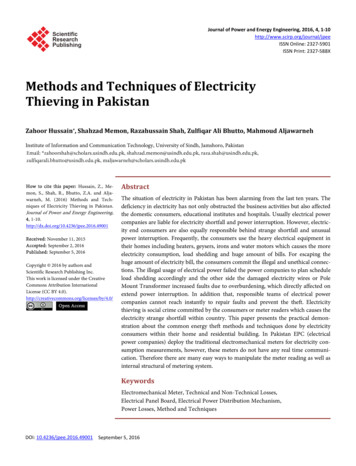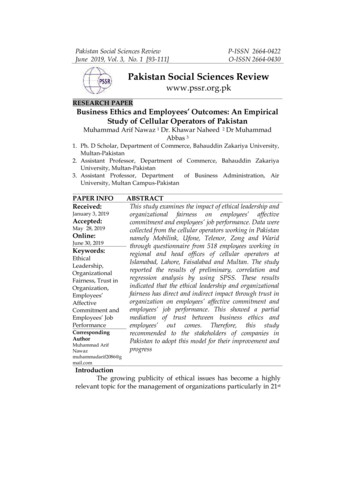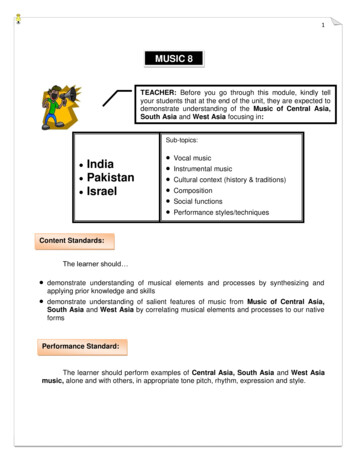
Transcription
1MUSIC 8TEACHER: Before you go through this module, kindly tellyour students that at the end of the unit, they are expected todemonstrate understanding of the Music of Central Asia,South Asia and West Asia focusing in:Sub-topics: IndiaPakistanIsrael Vocal musicInstrumental musicCultural context (history & traditions)CompositionSocial functionsPerformance styles/techniquesContent Standards:The learner should demonstrate understanding of musical elements and processes by synthesizing andapplying prior knowledge and skillsdemonstrate understanding of salient features of music from Music of Central Asia,South Asia and West Asia by correlating musical elements and processes to our nativeformsPerformance Standard:The learner should perform examples of Central Asia, South Asia and West Asiamusic, alone and with others, in appropriate tone pitch, rhythm, expression and style.
2LEARNING COMPETENCIES/OBJECTIVES Listen to songs from Central Asia, South Asia and West countries alone and/or withothers.Relate Central, Southern and West Asian countries’ music in the lives of the people.Analyze examples of music from Central, South Asia and West countries anddescribe how the elements are used.Explain the distinguishing characteristics of representative Central, South Asian andWest countries’ music in relation to the culture of the area.Perform using available instruments from Central Asia, South Asia and Westcountries alone and/or with others.Improvise simple rhythmic/harmonic accompaniments to music from selectedCentral, South and West Asian countries.Explore ways of producing sounds on a variety of sources that would simulateinstruments being studied.Sing vocal music from Central, South and West Asian countries alone and/withothers.Evaluate music and music performances applying knowledge of musical elementsand stylesTEACHER: Discuss the objectives.
3TEACHER: You may use all Pre-Assessment activities or you may just choose vocaland instrumental music activity. Find out if the students have an idea about Central,South and West Asia.PRE-ASSESSMENTBefore you start the lesson, let us find out how much you know aboutSouth, Central and West Asia. Here are some activities prepared for you.Are you ready?Pre-AssessmentActivity : “ Where in the World is ”You will need:blank map and coloring materialsDirections:1. Listen to the different music samples listed below. You may find them on the internetor let your teacher provide them for you. Match the music with the Asian region itcame from.2. Color each region with:Central Asia – VIOLETSouth Asia – REDWest Asia – GREENCarnatic MusicHindustani MusicPunjabi MusicArabic Music
Were you able to match the music to its region?How about naming the countries in each region? Can youname them?In your notebook, make a table similar to the one shownbelow and write the names of the countries that you know inthe table.CENTRAL ASIAKazakhstan, KyrgyzstanTajikistan, TurkmenistanUzbekistan, West PakistanSOUTH ASIABhutan, BangladeshIndia, MaldivesNepal, PakistanWEST ASIABahrain, Cyprus, EgyptIran, Iraq, Israel, JordanKingdom of Saudi Arabia,Kuwait, Lebanon, OmanPalestine, Qatar, Syria, TurkeyUAE, YemenDo you remember vocal music and instrumental music? As wehave discussed in the previous quarters, Asia is rich in these twotypes of music.Answer the following activities to check what you know.Vocal MusicAsia is a big continent consisting of several countries. Arewe going to study all of them? We cannot, but we can focus on afew representative ones from each region.ACTIVITY: Countries are written on the concept map below. On a sheet of paper, shareyour ideas about their vocal music. Copy the diagram.INDIA PAKISTAN ISRAEL Have you been to any of these countries? If you have, then you are very lucky! Take thetime to share about the countries you visited with your classmates.4
5Instrumental MusicIt was very nice of you to share your ideas about the vocalmusic of the countries above. What about Asian musicinstruments? Are you familiar with these instruments? Nameas many as you can!TablaOudHarmoniumSitarJewish LyreShofarPsalterionGobletToftRubabSo do you now have an idea of the things that we will belearning this quarter? It’s time to make your learning goals and specifythe things that you would want to learn about the music of Central Asia,South Asia and West Asian Countries. Write your goals in yournotebook. Follow the guide below.LEARNING GOALS AND TARGETSAt the end of this module,a.b.c.d.I would like to know aboutI would like to be able to do the ff:I would like to understandI would like to perform or produceTEACHER: Students will write their goals in their notebooks.
6Now that you have written your goals for this quarter, it’s time for usto officially start the lesson.TEACHER: Give a short background of each country’sculture. Prepare video and picture samples of Vocal andInstrumental groups.PART I. KNOWMusic has always been viewed as a universal language.In the vast region of Asia, religious music has been a commonground in uniting people with different languages, cultures and norms.Lesson 1: INDIAIndia is the largest country in South Asia. Its music isas vast as its geographic location and as large as itsdemographic population.The music of India reflects differentaspects of Asian culture through its timbre, rhythm, melody,texture, form and style. In general, Indian music remainsfundamental to the lives of the people of India as sources ofspiritual inspiration, cultural expression and entertainment.Galaxy of Musicians by Raja Ravi Varma
7TEACHER: Let the students compare each country’s music and make themrelate the music to their culture.Have you ever watched a Hindu singing ordancing? What is your impression on their way ofsinging or dancing? How important is music to theirdaily life?India's classical music tradition, includes Carnatic and Hindustani musicwhich have developed over many centuries.Music of India also includesseveral types of folk and popular music. One aspect of vocal music usesmelismatic singing with nasal vocal quality, as compared to the Philippinemusic which uses melismatic singing only in chanting epics and the pasyon.Singing based on a set of pitches was popular even from the Vedic times. TheSamagana style of singing developed into a strong and diverse tradition over severalcenturies becoming an established part of contemporary traditions in India. The hymns inSama Veda, a sacred text, were sung as Samagana and not chanted. Sama Veda is thethird of the four Vedas of Hinduism but ranks next to Rig Veda (Rigveda) in terms of itssanctity and liturgical importance.Rig Veda is also sung in the Samagana traditional singing style. Because of itsliturgical importance, Rigveda is counted as first among the four canonical sacred texts ofHinduism known as Vedas. Rig Veda is an ancient Indian sacred collection of VedicSanskrit hymns. Some of its verses are still recited as Hindu prayers at religious functionsand other occasions.Characteristics of Traditional Music from India:1. Carnatic musico refers to music from South Indiao directed to a Hindu god, which is why it is called “temple music”o unlike Hindustani music, Carnatic music is unified where schools are basedon the same ragas, same solo instruments (veena, flute, violin) and thesame rhythm instrument (mridangam and ghatam)o music pieces are mainly set for the voice and with lyricso compositions called krti are devotional songsAdditional Audio/Visual Activity: You may watch thefollowing links online. Carnatic Flute-Tamboori by Heramba & Hemantha, www.youtube.com Carnatic Vocal, www.carnaticsangeetham.com
82. Hindustani musico goes back to Vedic period times around 1000 BCo further developed in the 13th and 14th centuries AD with Persian influencesand from existing religious and folk musico predominantly found in the northern and central regionso influenced by ancient Hindu musical traditions, historical Vedic religion/Vedicphilosophy, native Indian sounds and enriched by the Persian performancepractices of the Mughal erao Nasal singing is observed in their vocal musico in North India, the most common style of singing is called khyal, a word whichmeans imaginationAdditional Audio/Visual Activity Hindustani Classical Music, www.wildfilmindia.com Pt. Bhimsen Joshi-Classical Vocal, www.youtube.comAfter learning about the vocal music of India, the next topic will help you learn theinstrumental music of India.INSTRUMENTAL MUSICThere are many musical instruments in India. Some instruments are used primarilyin North Indian music (Hindustani Sangeet) while many other instruments are used inSouth Indian music (Carnatic Sangeet). Instrumental music is often similar to vocalmusic but sometimes they have distinctive instrumental styles. There are five knowntraditional system for classification of instruments.Classification of Musical Instruments from India:1. Ghan – described as a non-membranous percussive instrument but with solidresonators. It is one of the oldest class of instrument in India. It may also be amelodic instrument or instruments to keep tal.GhatamKartaManjiraNout
92. Avanaddh - described as a membranous percussive instrument. This class ofinstruments typically comprise the drums.Daf (Duf, Daphu)DholTabla3. Sushir – also known as blown air. It is characterized by the use of air to excite thevarious resonators.BansuriShehnaiSurpetiShankh4. Tat – referred to as vina during the old civilization. This class of instruments areplucked (stringed instruments)SitarEktarGotuvadyamGopichandRabab
105. Vitat – described as bowed stringed instruments. One of the oldest classifications ofinstruments and yet did not occupy a place in classical Indian music until the last fewcenturies.banamchikaraesrajsarangiTALARhythm plays an important role in Indian music. It is fundamental tothe creation of any musical system. Certainly, from a historic stand point, rhythm existedmany centuries ago before the word “rag” was ever used. Given this historical preeminence, it is not surprising that rhythm occupies an important position in the Indiansystem of music.Tala - literally meaning ‘clap;’ variously transliterated as “tal”, “taal” or “taala”- is a regular, repeating rhythmic phrase, particularly as rendered on apercussive instrument with an ebb and flow of various intonationsrepresented as a ''theka''- is the common Indian system of rhythmTheka - a sequence of drum-syllables or ''bol''- in Indian classical music, both Hindustani classical music and Carnaticmusic use complex rules to create elaborate patterns of rhythmTabla - most common instrument for keeping rhythm in Hindustani musicMridangam - most common instrument for keeping rhythm in Carnatic music- also transliterated as “mridang”If available, use the interactive listening tools by WilliamAlves, in his audio-cd recordings: Interactive Music of the World,featuring musical instruments of India.
11Let’s see how much you have learned. Can you identify the differenceof Carnatic from hindustani music? Can you identify Indian musicalinstruments?TEACHER-ASSISTED ACTIVITY: Which Is Which?!Study the words written in the box. Identify which word fits the description ofCarnatic and Hindustani music. Write your answers on a ¼ sheet of Manila PaperKhyalUnifiedKrtiNasal SingingPersian InfluenceTemple ICHINDUSTANIMUSICINDIVIDUAL ACTIVITY: Name It!Name the following Indian musical instruments. Write the answers in a separate sheet of paper orin your notebook.2.3.5.6.1.4.7.8.10.9.
12So rhythm plays an important role in Indian music, what could bethe distinct characteristic of Pakistani music?Lesson 2: PAKISTANCentral Asian music encompasses numerous different musicalstyles originating from a large number of sources. Though Pakistan is part of South Asia, itswestern part is considered as extended Central Asia.Pakistan is known for its unique vocals. The distinctive Pakistani sound was formedwith multiple influences not only from various parts of South Asia but also includes diverseelements from Central Asia, Persia, Turkey and the Arab world.VOCAL MUSIC OF PAKISTANPakistan is known for its two vocal styles in singing:1. Ghazal are traditional expressions of love, separation and loneliness; it tells about both thepain of loss of the lover and the beauty of love in spite of that painits structural requirements are more strict than those of most poetic formstraditionally written in Englishis considered by many to be one of the principal poetic forms the Persian civilizationcan be sung by both for men and women Pakistani Ghazal-Payam e Mashriq’s Ghazal, www.youtube.com2. Qawwali the devotional music of the Chishti Order a vibrant musical tradition that stretches back more than 700 years originally performed mainly at Sufi shrines throughout the subcontinent and gainedmainstream popularity rahat fateh ali khan-best qawwali, www.youtube.comINSTRUMENTAL MUSIC nusrat fateh ali khan-best qawwali, www.youtube.com
13INSTRUMENTAL MUSIC OF PAKISTANPunjabi music strengthens the importance of musical instruments in Pakistan.Punjab is a region in South Asia which is divided into West Punjab, Pakistan andEast Punjab, India. Bhangra, one of the most recognized forms of Punjab, is based on thedrum rhythm of dhol.SIGNIFICANT INSTRUMENTS OF PAKISTANTablaDholakHarmoniumRubabAre you ready to check what you have learned from the music ofPakistan? The next activity will help you test if you had understood theconcepts learned about the music of Pakistan. Good Luck!INDIVIDUAL ACTIVITY: Peace, Order and Organize!Compare and contrast the vocal/instrumental music of Pakistan from themusic of India. Draw this diagram on a sheet of paper and answer.VOCAL & INSTRUMENTAL MUSICPakistanIndiaSIMILARITIESDIFFERENCES
14Pakistan acted as a major crossroad for variouscultures between Central Asia, South Asia and WestAsia. This paved the way for the
TEACHER: Before you go through this module, kindly tell your students that at the end of the unit, they are expected to demonstrate understanding of the Music of Central Asia, South Asia and West Asia focusing in: 2 Listen to songs from Central Asia, South Asia and West countries alone and/or with others. Relate Central, Southern and West Asian countries’ music in the lives of the people .
